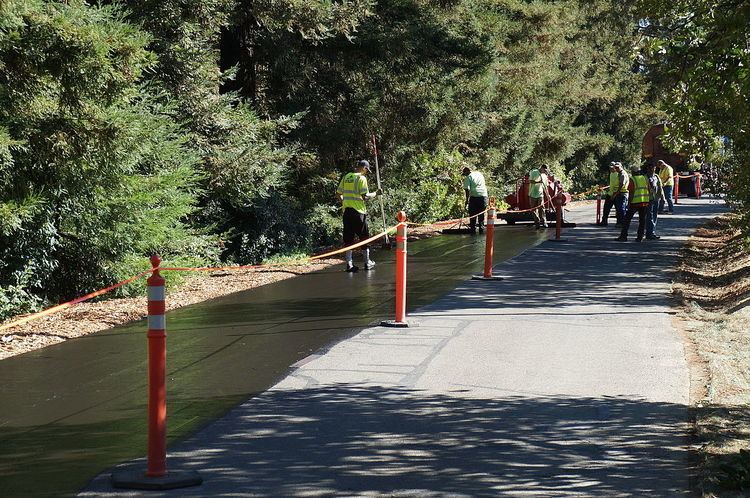 | ||
Sealcoat or pavement sealer is liquid coating mixture that is applied to asphalt based pavement.
Contents
Benefits
Sealcoat or pavement sealer is a protective coating for asphalt-based pavements. Sealcoat is much like paint used to protect wood from the environment. Since asphalt pavements are porous, a sealcoat or pavement sealer is utilized in order to shed water and other chemicals from the deterioration of the asphalt pavement. This is especially important in those areas that are subject to a freeze/thaw cycle. Petroleum-based chemicals from automobiles are another source of pavement deterioration. Example of these automobile chemicals include gasoline, motor oil, and engine coolant just to name a few.
Sealcoating may also reduce the friction or anti-skid properties associated with the exposed aggregates in asphalt.
Detriments to Sealcoat
Not all pavement sealcoat are created equal. For example, refined tar-based sealer offers the best protecting against water penetration and chemical resistance. Asphalt-based sealer typically offers poor protection against environmental chemical and harsher climates (salt water). Petroleum-based sealer offer protection against water and chemicals somewhere between the other two sealers. Another difference between coatings is in terms of wear. Again, refined tar-based sealer offers the best wear characteristics (typically 3–5 years) while asphalt-based sealer may last 1–3 years. Petroleum-based sealer falls between refined tar and asphalt.
One perceived detriment associated with pavement sealer is its discharge to the environment after it is abraded from the surface of the pavement. Some states in North America have banned the use of coal tar–based sealants primarily based on United States Geological Survey studies. The industry group that represents sealcoat manufacturers has performed numerous research and reviews of the USGS and have found it to be erroneous, biased (citation and white hat, to name a few) and too generalized in order to draw the conclusions they claim.
Types
There are primarily three types of pavement sealers. They are commonly known as refined tar-based (coal tar based), asphalt-based, and petroleum-based. All three have their advantages but are typically chosen by the contractors’ preference unless otherwise specified.
Application methods
Prior to application the surface must be completely clean and dry using sweeping methods and/or blowers. If the surface is not clean and dry, then poor adhesion will result. Pavement sealers are applied with either pressurized spray equipment, or self-propelled squeegee machines or by hand with a squeegee. Equipment must have continuous agitation to maintain consistency of the sealcoat mix. The process is typically a two-coat application which requires 24 to 48 hours of curing before vehicles can be allowed back on the surface. Once the surface is properly prepared, then properly mixed sealer will be applied at about 60 square feet per gallon per coat.
Polycyclic aromatic hydrocarbons
Some studies that suggest that refined tar sealants are a significant contributor to polycyclic aromatic hydrocarbon levels in streams and creek beds and that the continual application of sealcoats may be a significant factor. As a result, a few municipalities in the United States have banned this material. The same studies also suggest that it can be harmful if ingested before curing and ingesting soil or dust contaminated by eroded coal tar sealant. It is also known to have effects on fish and other animals that live in water.
